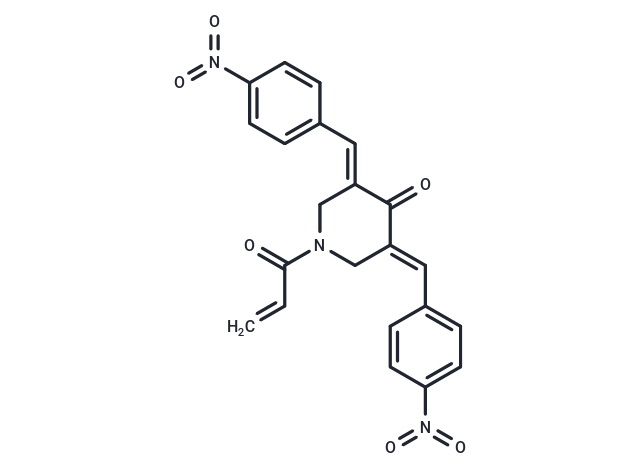Shopping Cart
Remove All Your shopping cart is currently empty
Your shopping cart is currently empty
B-AP15 (NSC-687852)(NSC-687852) is a selective inhibitor of the deubiquitinating enzymes Usp14 and UCHL5 of the 26S proteasome. It blocks the deubiquitinating activity of the 26S proteasome.

| Pack Size | Price | USA Warehouse | Global Warehouse | Quantity |
|---|---|---|---|---|
| 5 mg | $32 | In Stock | In Stock | |
| 10 mg | $52 | In Stock | In Stock | |
| 25 mg | $89 | In Stock | In Stock | |
| 50 mg | $133 | In Stock | In Stock | |
| 100 mg | $225 | In Stock | In Stock | |
| 200 mg | $397 | In Stock | In Stock | |
| 500 mg | $676 | In Stock | - |
| Description | B-AP15 (NSC-687852)(NSC-687852) is a selective inhibitor of the deubiquitinating enzymes Usp14 and UCHL5 of the 26S proteasome. It blocks the deubiquitinating activity of the 26S proteasome. |
| Targets&IC50 | UCHL5:2.1 μM |
| In vitro | In mice with HCT-116 colon carcinoma xenografts, B-AP15 (5 mg/kg) significantly delayed tumor onset. Additionally, in severely immunodeficient mice bearing squamous cell carcinoma xenografts, B-AP15 (5 mg/kg) demonstrated notable antitumor activity. |
| In vivo | As a UPS (Ubiquitin-Proteasome System) inhibitor, B-AP15 induces cell death by triggering the cathepsin-D-dependent lysosomal apoptotic pathway. Compared to peripheral blood mononuclear cells or immortalized epithelial cells (hTERT-RPE1), B-AP15 exhibits greater cytotoxicity towards HCT-116 cells. It dose-dependently accumulates the UbG76V-YFP receptor (IC50: 0.8 μM), indicating impaired proteasomal degradation. When applied to human colon cancer HCT-116 cells, B-AP15 (1 μM) rapidly accumulates polyubiquitinated proteins. At a concentration of 1 μM, B-AP15 inhibits the release of IL-1β induced by ATP from lipopolysaccharide-induced peritoneal macrophages. In THP-1 cells, 1 μM B-AP15 reduces the level of cell death induced by nigericin and significantly decreases the formation of ASC specks in lipopolysaccharide-induced THP-1 cells treated with nigericin. Additionally, B-AP15 (1 μM) causes a G2/M phase cell cycle arrest and accumulation of cell cycle inhibitors in HCT-116 cells. At 2.2 μM, B-AP15 dose-dependently increases the levels of the cyclin-dependent kinase inhibitors CDKN1A and CDKN1B, and the tumor suppressor gene TP53, without affecting the levels of ornithine decarboxylase 1. |
| Kinase Assay | For deubiquitinase inhibition assays, 19S regulatory particle (5 nM), 26S (5 nM) UCH-L1 (5 nM), UCH-L3 (0.3 nM), USP2CD (5 nM) USP7CD (5 nM) USP8CD (5 nM) or BAP1 (5 nM) is incubated with DMSO or b-AP15 and monitored the cleavage of ubiquitin-AMC (1,000 nM) using a Wallac VICTOR Multilabel counter or a Tecan Infinite M1000 equipped with 380 nm excitation and 460 nm emission filters[1]. |
| Cell Research | b-AP15 is dissolved in DMSO and stored, and then diluted with appropriate medium before use[2]. Cell viability is monitored by either the fluorometric microculture cytotoxicity assay or the MTT assay. For the MTT assay, cells are seeded into 96-well flat-bottomed plates overnight and exposed to drugs, using DMSO as the control. At the end of incubations, 10 μl of a stock solution of 5 mg/mL MTT is added into each well, and the plates are incubated 4 hours at 37°C. Formazan crystals are dissolved with 100 μL 10% SDS/10 mM HCl solution overnight at 37°C. Absorbance is measured using an enzyme-linked immunosorbent assay (ELISA) plate reader at 590 nm[2]. |
| Synonyms | NSC 687852 |
| Molecular Weight | 419.39 |
| Formula | C22H17N3O6 |
| Cas No. | 1009817-63-3 |
| Smiles | C(=C\1/C(=O)\C(=C\C2=CC=C(N(=O)=O)C=C2)\CN(C(C=C)=O)C1)\C3=CC=C(N(=O)=O)C=C3 |
| Relative Density. | 1.416 g/cm3 (Predicted) |
| Storage | Powder: -20°C for 3 years | Shipping with blue ice/Shipping at ambient temperature. | ||||||||||
| Solubility Information | DMSO: 1 mg/mL (2.38 mM), Sonication is recommended. | ||||||||||
Solution Preparation Table | |||||||||||
DMSO
| |||||||||||
| Size | Quantity | Unit Price | Amount | Operation |
|---|

Copyright © 2015-2025 TargetMol Chemicals Inc. All Rights Reserved.